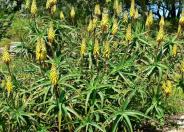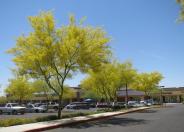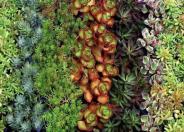
Common name:Century Plant
Botanical name:Agave americana variegata mediopicta
This form has arching leaves with a creamy white stripe down the center of the blue-green leaf. The leaves are outstanding with their arching form and are well armed with a stout, terminal spine as well as marginal teeth. It is somewhat smaller than americana getting to around 4.' It prefers full sun, well drained soil and will perform well in containers. This form also will die after bloom but will survive in the form of new pups around the old plant.

Common name:Century Plant, Maguey
Botanical name:Agave americana
Fast growing to about 6-10' tall x 8-13' wide. Wide, grey leaves have stiff terminal spines and recurved teeth on margins. Prefers full sun and well-drained situations. Prone to agave snout weevil which will eat the roots and heart out. After blooming, which could take several years. it will die but will send up new pups from around the base. Some people are allergic to the sap. Removal is difficult if unwanted.

Common name:Hardy Aloe
Botanical name:Aloe striatula
Aloe striatula is a robust, rambling plant that can form a large shrub of up to 6.7 feet (2 m) in height. The leaves are dark green and strongly recurved, with numerous small white teeth along their margins. The flowers are yellow and orange and appear densely on up to 16 inches (40 cm) tall, un-branched, cone-shaped racemes throughout the summer.

Common name:Desert Museum Palo Verde
Botanical name:Parkinsonia 'Desert Museum'
Striking, generally multi-trunked, deciduous tree to 25' tall and wide. Three-way cross between P. aculeata, P. microphyllum, and P. floridum. Trees are thornless and produce abundant clusters of yellow fragrant flowers in the spring that attract bees. This tree has a smooth green colored trunk. Leaves are tiny and light green. It does best in full sun in clay, loam or sandy soil. Very attractive. Mature trees are drought tolerant.

Common name:Weeping Blue Atlas Cedar
Botanical name:Cedrus atlantica 'Glauca Pendula'
Another large, slow-growing conifer which exhibits weeping growth form. Its golden leaves are 1" in size, and it also requires full sun in order to best develop its color. It serves as an excellent specimen or rock garden subject.

Common name:Big Bend Yucca
Botanical name:Yucca rostrata
This Yucca has blue leaves, a tall narrow trunk, and a spectacular summer display of cream white flowers. It is one of the most attractive tree Yuccas. It slowly forms a trunk to 10' tall. The young are usually unbranched; the older have a few branches. Narrow blue leaves can grow up to 2' long but very narrow with a sharp term spine. This Yucca prefers full sun or very light shade and rocky, well drained soil. It is susceptible to grubs. Old leaves persist.

Common name:Purple Smoke Tree
Botanical name:Cotinus coggygria 'Purpureus'
A deciduous shrub or small tree that grows up to 10' tall, the purpureus is grown for its wispy, thread-like flower clusters and outstanding fall color. Its foliage has a redish purple color that turns somewhat green in summer.
The plant requires sun to part shade, with little or no summer water. -Monterey Bay Nursery

Common name:Stonecrop
Botanical name:Sedum spp.
Sedum is a large and varied genus in the Crassulaceae family that encompasses more than 450 species. Sedum varieties are native throughout the northern hemisphere, Africa and South America. This genus of succulents is remarkable for its diversity of color, form, texture and even hardiness. Vibrant foliage and fanciful blooms abound. Some sedum are hardy to the bitterly cold climes of zone 3, while others cannot tolerate a hard frost. Some are just a couple of inches tall, making an excellent ground cover, while others reach 2-3 feet and are used as border plants. Still others trail and make dramatic additions to hanging baskets. Like all succulents, sedum store water in their foliage for use during times of drought. They also employ a more specialized strategy for dealing with hot, dry climates. Sedum are often divided in the tall, border varieties that grow 1-3 feet tall, and the groundcover sedum. In fact, horticulturalists and taxonomists have recently reclassified the border sedums as Hylotelephium – separate from the sedum genus. But this focus on size seems to be missing the point. Certainly, if you are looking for a groundcover, or specifically for a border plant, knowing the plant’s mature size is important. But I feel that dividing sedum into cold-hardy varieties and those tender to frost is more valuable to the home gardener. Many of the tallest and the smallest sedum thrive in climates with snow and sleet. Sedum are cherished the world over for their bright foliage, long-lasting blooms and easy care nature. Some varieties have been used as a food source, others are integral in beauty products. Sedum are invaluable in the growing movement toward “green roofs”, where they are often interplanted with sempervivum. Green roofs or living roofs provide tremendous insulation, thereby cutting energy use and costs. They absorb rainwater, create habitat and support for wildlife and mitigate the heat island effect in cities. Although many varieties of sedum are hardy to zone 3, there is a large subset of varieties that are not hardy below zone 9! These tender sedum varieties are typically small-leafed, with vivid foliage and bright, colorful flowers that are highly appealing to butterflies. They are excellent for use in rock gardens and containers, happily growing outdoors year round in very mild climates. They will over-winter indoors where winter is cold. Just provide as much light as possible. All sedum varieties, both tall and small, hardy and tender, produce wonderfully long-lasting blooms. They are a good source of nectar for butterflies and bees, and lend colorful texture to the garden. Bloom times vary widely, and it is possible to plant a garden that ensures sedums are in bloom nearly all year round. The flowering stems of the tall, border varieties make excellent cut flowers with a good vase life. Like all succulents, sedum requires fast-draining, nutritionally lean soil to thrive. Though not as sensitive as some succulents, sedum do require a light hand with the water.
Designer:
Photographer: Vicki Anderson
Maintain a two to four inch layer of mulch on the soil surface to reduce weeds, infiltrate rain water, and reduce compaction.
Drip and other smart irrigation delivers water directly to roots, allowing no excess water for weeds.